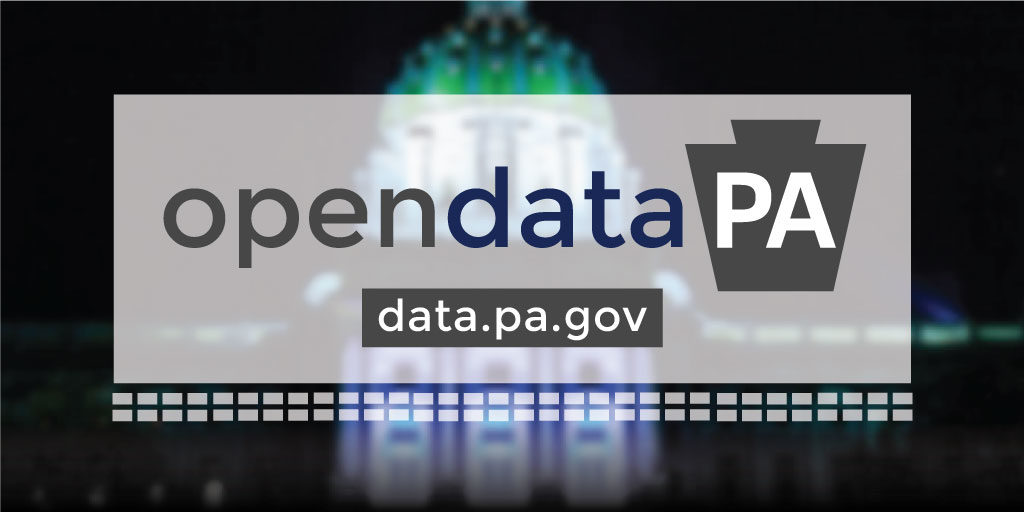The Pennsylvania Historical and Museum Commission (PHMC) is pleased to announce the recent addition of two datasets to OpenDataPA: Pennsylvania Historical Markers and the 1850 Agricultural Production in Pennsylvania. Wondering what datasets and open data have to do with the PA SHPO? Lots, apparently.
OpenDataPA
In August 2016, the Commonwealth of Pennsylvania launched OpenDataPA, a portal “to make data available in order to engage citizens, create economic opportunities for businesses and entrepreneurs, and develop innovative policy solutions that improve program delivery and streamline operations.” Several state agencies have contributed datasets related to jobs, schools, infrastructure and more. Governor Wolf’s website includes the announcement about the OpenDataPA launch and frequently asked questions about open data.
OpenDataPA Banner
Open data refers to data in a format that can be understood by a computer and used freely by anyone, free of any constraints. Here are some key principles incorporated into the development of OpenDataPA:
- Availability and Access: the data must be available as a whole in a convenient and modifiable form.
- Reuse and Redistribution: the data must be provided under terms that permit reuse and redistribution including the intermixing with other datasets.
- Universal Participation: everyone must be able to use, reuse, and redistribute the data—free of restrictions
Open Data & Preservation
Open data, especially open government data, is a tremendous resource that is as yet largely untapped. OpenDataPA brings more transparency, accountability, modernization, and innovation to Pennsylvania government by making government data open and centralized. They’ve even provided tutorials for users to understand how to use the website and datasets.
So far, 47 datasets have been uploaded to the website, more are expected as the program takes hold. Agencies like the Department of Community and Economic Development (DCED) and the Department of Transportation (PennDOT) have uploaded information that is pertinent to community and regional planning, preservation planning, and cultural resources management.
Pennsylvania Historical Markers
Since 1913 PHMC has administered the Pennsylvania Historical Marker Program to capture the memory of people, places and events that have affected Pennsylvanians over the centuries. More than 2,400 bronze plaques and cast aluminum markers tell the stories of Native Americans and settlers, government and politics, sports and entertainment, struggles for freedom and equality, factories and businesses, and a multitude of other topics.
“Nessmuk” marker for George Washington Sears and his writings about Pine Creek Gorge in Tioga County.
This dataset isn’t online yet, but should be very soon. You can access this dataset, which includes markers by title, dedication date, location, county, category and marker text, in the next few weeks here. If you don’t see it on your first try, make sure to check back!
1850 Agricultural Production in Pennsylvania
Agriculture has guided Pennsylvania’s economic growth and cultural development and has profoundly shaped the lands and people of the commonwealth. The 1850 Federal Decennial Census was the first time in history that data was collected on agricultural production at a national scale. The census manuscripts for Pennsylvania were digitized by PHMC from the original documents in the collections of the National Archives and Records Administration.
One of 12 maps created from 1850 agricultural census, available online at http://www.phmc.state.pa.us/portal/communities/agriculture/maps/index.html.
This dataset includes agricultural production data compiled from Schedule 4 – Productions of Agriculture of the 1850 census and aggregated at the county and municipality level. In additional to using this primary resource for your research about agriculture in Pennsylvania, you can also check out the PA SHPO’s Agricultural Resources in Pennsylvania, ca. 1700-1944 historic context and other resources.
CODE4PA Hackathon
To help promote transparency and efficiency in government, Harrisburg University has teamed with the Technology Council of Central Pennsylvania in support of the Commonwealth of Pennsylvania Office of Data and Digital Technology to host the CODE4PA Hackathon at Harrisburg University’s main campus in downtown Harrisburg, and the newly expanded Philadelphia location on Sept. 29-Oct. 1. The hackathon will take place simultaneously at both locations.
Programmers, developers, designers, project managers and all others interested in working with data to help promote governmental transparency, while competing for cool gifts and prizes, will not want to miss this one-of-a-kind event!
What Will You Create?
Earlier this year I used the 1850 agricultural census data to create a dashboard for my data visualization graduate school course project. It won first place in Tableau’s Student Viz Assignment Contest. This is just one example of what you can create with PHMC’s data.
Additional ideas include a location-based app, game or scavenger hunt, walking or driving tour, photo or comment submissions, or marker maintenance app. Use your creativity to combine ideas and data or come up with your own app ideas.
Leave a message in the comments if you participate in the hackathon or use PHMC’s datasets. We would love to hear about what you have created with our data!
Comment Policy
PHMC welcomes and encourages topic-related comments on this blog. PHMC reserves the right to remove comments that in PHMC’s discretion do not follow participation guidelines.
Commenters and Comments shall be related to the blog post topic and respectful of others who use this site.
Commenters and Comments shall not: use language that is offensive, inflammatory or provocative (this includes, but is not limited to, using profanity, obscene, or vulgar comments); disparage other commenters or people; condone illegal activity; identify the location of known or suspected archeological sites; post personal information in comments such as addresses, phone numbers, e-mail addresses or other contact details, which may relate to you or other individuals; impersonate or falsely claim to represent a person or an organization; make any commercial endorsement or promotion of any product, service or publication.
If you would like to comment on other topics not related to this blog post but related to PHMC, please fill out the PHMC Contact Us Form.
